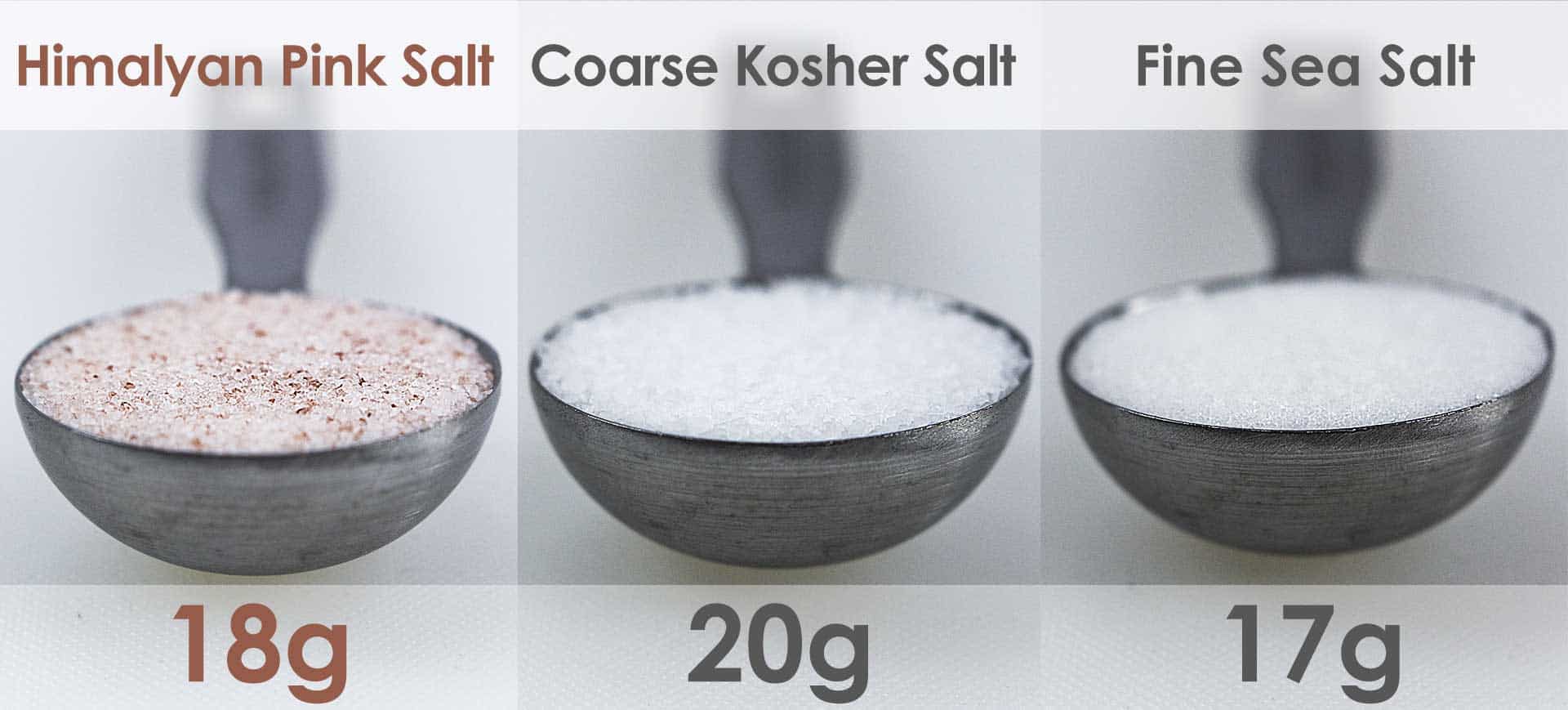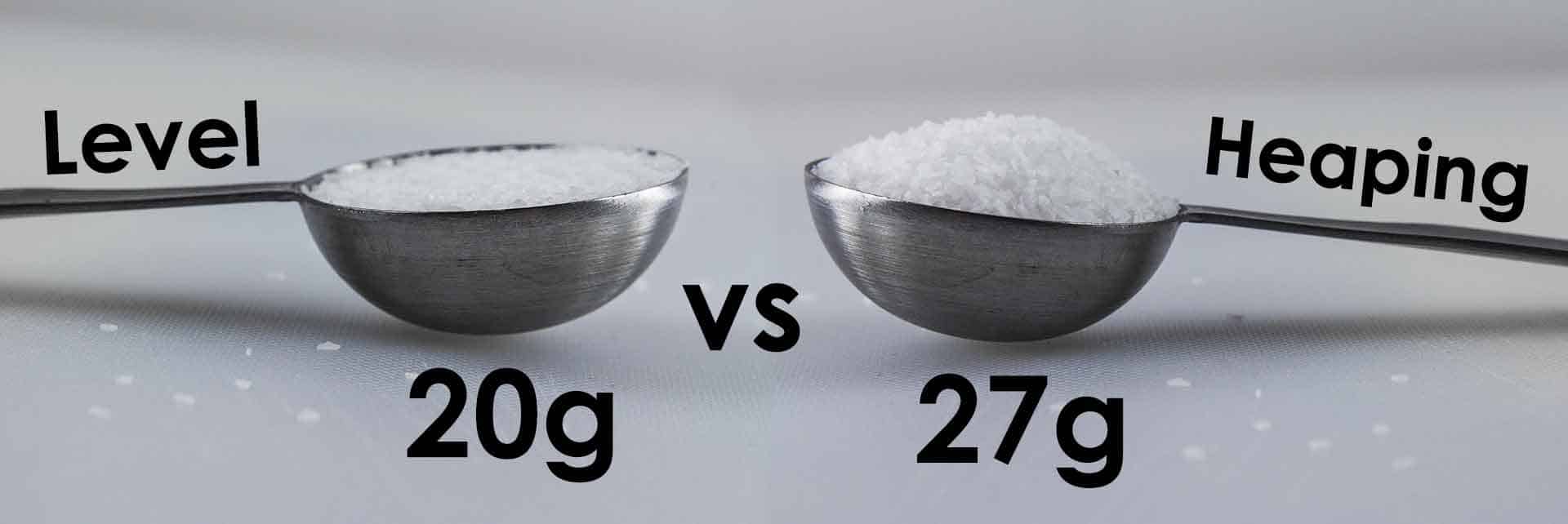
Tablespoons, Salt, and Sauerkraut – The Measuring Problem
Most Sauerkraut recipes call for 3 tablespoons of salt for every five pounds (2.3kg) of cabbage.
The problem with measuring salt with a tablespoon boils down to one thing:
Inaccuracy.
For example. Sauerkraut recipes do not tell you:
- that various salt types measure differently in a tablespoon
- if a level or heaping tablespoon is needed
- the exact brand or type of salt to use much of the time
All Tablespoons of Salt are not Created Equal when making Sauerkraut
You see, some salt is coarse, some fine and some in between. One tablespoon of any of these is actually a different amount of salt. So, one tablespoon of fine grain salt will generally weigh more than coarse salt. That’s because more of the finer granules can fit into one tablespoon. The granules are closer together and packed more tightly. Think of it like this. Marbles fit more tightly in a box than beach balls. There’s larger air pockets between each beach ball and air weighs pretty much nothing.
As a consequence, you may be adding extra salt (or not enough) to your Sauerkraut without knowing it. This essentially changes the outcome of your sauerkraut. Often for the worse.
Strangely, from my own measurements, I've discovered smaller granules of salt do not always weigh more than larger granules. I found it can also depend on the brand, type, and density of the actual grains of salt. This definitely makes things more confusing. To simplify the matter, weigh your salt. No questions asked. Problem solved.
Let’s take a look at how the weight of different types of salt differs. Keep in mind each one of these three below is exactly one level tablespoon.
For this example we’ll take a look at three different salts:
- Himalayan Pink Salt
- Coarse Kosher Salt
- Fine Sea Salt

So, obviously, measuring salt by the tablespoon is not going to give you the correct amount of salt for your sauerkraut. There are just too many variables.
Salt for Sauerkraut – Up Close and Personal
Let’s get a closer look at different types of salt in the photo below.
Notice how the sizes of the salt crystals are noticeably different from one another? The smaller the salt grain, the more weight you can fit into a single tablespoon. (usually)

There’s quite a difference between them, isn’t there?
This table will illustrate how much of a difference that can make when a sauerkraut recipe calls for three tablespoons of salt.
| Salt Type | 3 Tablespoons (in grams) |
|---|---|
| Pink Himalayan Salt | 54g |
| Great Value Coarse salt | 60g |
| Regular table salt | 51g |
| Windsor Coarse Kosher salt | 48g |
| Windsor coarse pickling salt | 48g |
As a result, you may be adding up to 12g too much or 12g too little salt to your sauerkraut.
Level or Heaping Tablespoon of Salt
Most sauerkraut recipes don’t tell you if you should be using a level tablespoon, a heaping tablespoon, or something in between. A leveled tablespoon is where you slide a butter knife across the top of the spoon. It leaves the salt exactly level with the height of the tablespoon. On the other hand, a heaping tablespoon of salt resembles a mini “mountain” of salt that sits above the height of the spoon. Most sauerkraut recipes don’t tell you which one of the two to measure. Level or heaping? It’s your guess.
Can you spot the difference between these two salt measurements?

Tablespoons of Salt from Different Countries
What makes matters worse is that the size of a tablespoon made in one country is sometimes different than another country. For instance, Australia uses a 20ml tablespoon. In contrast, most of the rest of the world uses a 15ml tablespoon. Further to that, North America does not have a legal standard on what size a tablespoon should be made. It's not an official measurement. So it's really up to the manufacturer to decide exactly how big your tablespoon will actually be.
In conclusion, promise me you’ll never, never, ever measure salt by a tablespoon again when you make sauerkraut. It may seem easy to do, but your sauerkraut will suffer. Instead use a cabbage to salt ratio. Weigh both the salt and cabbage on a kitchen scale. It makes great sauerkraut every time!
Extra bonus resources for you:
- Cook's Info has more info about tablespoons from different countries.
- Serious Eats discusses the innaccuracy of measuring salt with a tablespoon.
And while you’re here…please do leave a comment. Ask a question. Let us know your experience or opinion. I’d love to hear it!
Happy Cooking!
Anton


Jon says
So how many grams of salt to cabbage?
Anton says
Hi Jon, thanks for stopping by!
The amount of grams of salt for cabbage when making sauerkraut is 2% of the weight of the cabbage. You can find a full explanation on our site in the post called how much salt do I use for sauerkraut along with a salt ratio calculator to do the math for you.
If you have any other questions don't hesitate to ask.
Take care,
Anton
Lori Stockwell-Davis says
This was very helpful. Thankyou I will be more precise measuring from now on. I especially liked the science of the fermenting process and differences of weights of various types of salt.
Lori
Anton says
Hi Lori,
You're very welcome. I hope it helps you with your fermenting.
I've always considered fermenting very much like a chemistry/biology experiment in your own home...that you can eat of course. 🙂
Good luck with your salt measurements.
Anton
Maggie says
So what is the best salt to cabbage ratio for sauerkraut?
Anton says
Hi Maggie,
Thanks for dropping by.
There is no exact 'best' ratio. But, a great place to start is 2% salt to cabbage by weight.
This assumes you can maintain a temperature between 16°Celsius to 21° Celsius (60°Fahrenheit to 70° Fahrenheit).
And, you'll be fermenting for about 21 to 28 days.
Anton